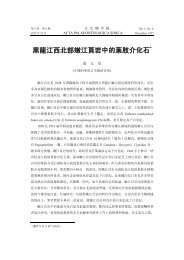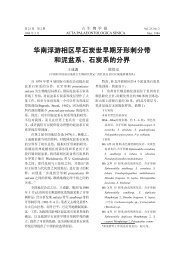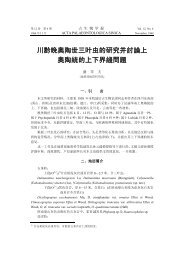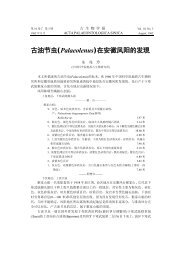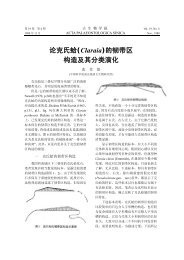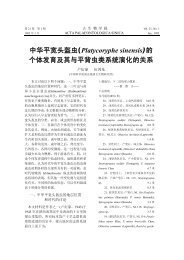ephedroids from the Early Cretaceous Yixian Formation in Liaoning ...
ephedroids from the Early Cretaceous Yixian Formation in Liaoning ...
ephedroids from the Early Cretaceous Yixian Formation in Liaoning ...
You also want an ePaper? Increase the reach of your titles
YUMPU automatically turns print PDFs into web optimized ePapers that Google loves.
240 C. Ryd<strong>in</strong> et al.: <strong>Cretaceous</strong> <strong>ephedroids</strong> <strong>from</strong> Ch<strong>in</strong>a<br />
1982) and <strong>from</strong> Australia (Krassilov et al.<br />
1998). There are also many undescribed specimens<br />
<strong>from</strong> Ch<strong>in</strong>a and Brazil (see e.g. Wu et al.<br />
2000, Mohr et al. 2004). <strong>Early</strong> <strong>Cretaceous</strong><br />
mesofossils <strong>in</strong>clude coalified seeds with unique<br />
Ephedra characters such as a sclerenchymatic<br />
seed envelope with apical papillae, and <strong>in</strong> situ<br />
polyplicate pollen (Ryd<strong>in</strong> et al. 2004, Ryd<strong>in</strong> et<br />
al. 2006).<br />
In addition to <strong>the</strong> ephedroid fossils <strong>the</strong>re<br />
are also a few <strong>Early</strong> <strong>Cretaceous</strong> megafossils<br />
that may represent <strong>the</strong> Welwitschia-Gnetum<br />
clade (Crane and Upchurch 1987, Ryd<strong>in</strong> et al.<br />
2003, Dilcher et al. 2005, Ryd<strong>in</strong> et al unpubl.<br />
data), as well as several gnetalean fossils that<br />
are difficult to assign to any of <strong>the</strong> extant<br />
l<strong>in</strong>eages (e.g. Krassilov 1982, Krassilov and<br />
Bugdaeva 1982, Krassilov 1986, Krassilov and<br />
Bugdaeva 1988, Duan 1998, Sun et al. 2001).<br />
Fur<strong>the</strong>r, dispersed seeds and pollen assigned to<br />
<strong>the</strong> ext<strong>in</strong>ct order Erdtmani<strong>the</strong>cales (Pedersen<br />
et al. 1989, Friis and Pedersen 1996, Kvaček<br />
and Pacltová 2001) are probably related to<br />
Gnetales, but <strong>the</strong> vegetative morphology of<br />
<strong>the</strong>se plants is unknown.<br />
Pre-<strong>Cretaceous</strong> evidence of <strong>the</strong> Gnetales<br />
are ma<strong>in</strong>ly dispersed polyplicate ephedroid<br />
pollen (e.g. Wilson 1962), but <strong>the</strong>re are also<br />
several records of megafossils that probably<br />
belong to <strong>the</strong> Gnetales, for <strong>in</strong>stance Ephedrites<br />
s<strong>in</strong>ensis Wu et al. and E. exhibens Wu et al.<br />
<strong>from</strong> <strong>Early</strong> Jurassic deposits <strong>in</strong> Q<strong>in</strong>ghai, Ch<strong>in</strong>a<br />
(Wu et al. 1986). However, most pre-<strong>Cretaceous</strong><br />
gnetalean megafossils are difficult to<br />
<strong>in</strong>terpret. The Permian cone Palaeognetaleana<br />
auspicia Wang with <strong>in</strong> situ polyplicate pollen<br />
(Wang 2004), <strong>the</strong> Late Triassic plant Dechellyia<br />
gormani Ash (Ash 1972), and <strong>the</strong><br />
Jurassic Ust-Balej fossils of East Siberia<br />
(Krassilov and Bugdaeva 1988), are all examples<br />
of fossils that have been discussed as<br />
putative Gnetales, but for which a precise<br />
systematic aff<strong>in</strong>ity rema<strong>in</strong>s to be established.<br />
In this study we describe a number of<br />
ephedroid fossils <strong>from</strong> <strong>the</strong> Liaon<strong>in</strong>g prov<strong>in</strong>ce<br />
of nor<strong>the</strong>astern Ch<strong>in</strong>a collected <strong>in</strong> sediments of<br />
<strong>the</strong> <strong>Yixian</strong> <strong>Formation</strong>. The <strong>Yixian</strong> <strong>Formation</strong><br />
and <strong>the</strong> overlay<strong>in</strong>g Jiufotang <strong>Formation</strong> com-<br />
prise <strong>the</strong> Jehol Group, famous for its exceptionally<br />
rich biota, which <strong>in</strong>clude exquisitely<br />
preserved <strong>in</strong>vertebrates, osteichthyan fish,<br />
amphibians, mammals and reptiles <strong>in</strong>clud<strong>in</strong>g<br />
fea<strong>the</strong>red d<strong>in</strong>osaurs and early birds (Chang<br />
et al. 2003). Vigorous collisions of plates <strong>in</strong> <strong>the</strong><br />
western rim of <strong>the</strong> Pacific resulted <strong>in</strong> <strong>in</strong>tensive<br />
volcanic activity (Wang et al. 1983) dur<strong>in</strong>g <strong>the</strong><br />
deposition of <strong>the</strong> <strong>Yixian</strong> <strong>Formation</strong> and ash<br />
falls repeatedly entombed organisms present <strong>in</strong><br />
<strong>the</strong> area and effectively prevented scaveng<strong>in</strong>g<br />
and bacterial decay. The immediate anoxic<br />
conditions provided by <strong>the</strong> volcanic ash tuffs<br />
permitted <strong>the</strong> preservation of orig<strong>in</strong>al softtissue<br />
features and stomach contents (Chen<br />
et al. 1998, Zhou and Zhang 2002); even<br />
questions on <strong>the</strong> physiology of <strong>Cretaceous</strong><br />
vertebrates and of plant-animal <strong>in</strong>teractions<br />
can be addressed (Zhou et al., 2003, and<br />
papers <strong>in</strong> Chang et al. 2003).<br />
In contrast to <strong>the</strong> anatomical preservation<br />
of many animals of <strong>the</strong> Jehol Biota, plant<br />
fossils rarely have cellular details <strong>in</strong>tact. Similar<br />
to <strong>the</strong> slightly younger Crato plants of<br />
Brazil, <strong>the</strong> Jehol plants are compression or<br />
impression fossils, often with various organs<br />
such as stems, leaves and reproductive structures<br />
still attached. In rare cases even whole<br />
plants are preserved provid<strong>in</strong>g excellent <strong>in</strong>formation<br />
on gross morphology. Anatomical<br />
features, however, are rarely preserved (e.g.<br />
Wu 1999, Sun et al. 2001, Chang et al. 2003,<br />
Friis et al. 2003, Leng and Friis 2003) and<br />
tissues are often replaced or filled <strong>in</strong> with pyrite<br />
framboids and microcrystall<strong>in</strong>es (Leng and<br />
Yang 2003).<br />
The Jehol flora comprises a diverse assemblage<br />
of bryophytes, lycopods, sphenopsids,<br />
ferns and various seed plants <strong>in</strong>clud<strong>in</strong>g many<br />
conifers and rare angiosperms (Sun et al. 1998,<br />
Wu 1999, Sun et al. 2001, Sun et al. 2002, Leng<br />
and Friis 2003, Leng et al. 2003, Wu 2003).<br />
Fossils assignable to <strong>the</strong> Gnetales (Wu 1999,<br />
Sun et al. 2001, Wu 2003) also show some<br />
diversity and <strong>in</strong>clude plants described as<br />
Liaoxia chenii Cao et Wu and Eragrosites<br />
changii Cao et Wu (Cao et al. 1998), Chaoyangia<br />
liangii (Duan 1998, later synonym of




